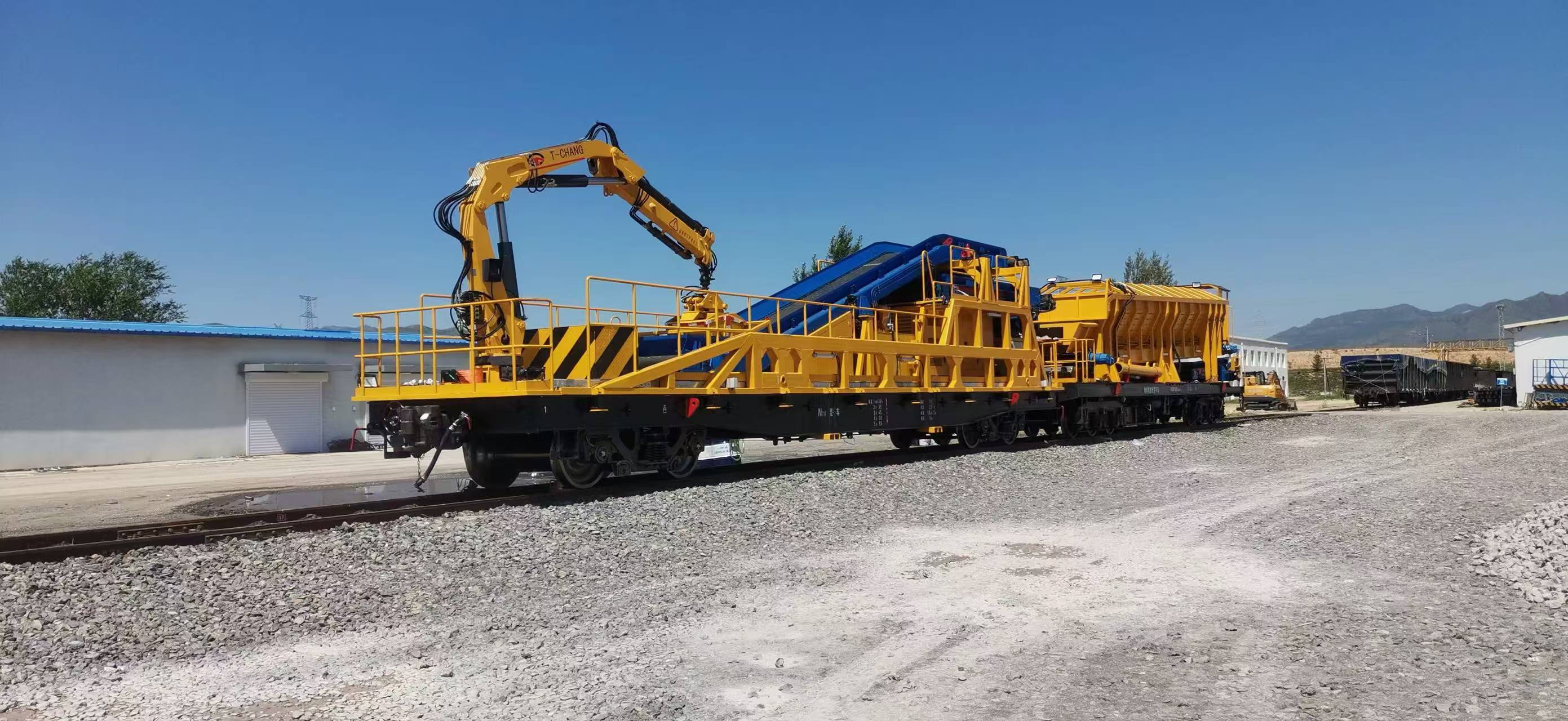Service Telephone
+86-17773308230
Railway Mechanical Automated Soil Cleaning and Transfer Vehicle
update time:2024/10/25 15:40:10
1.1 The Railway Mechanical Automated Soil Cleaning and Transfer Vehicle is composed of an operation cleaning vehicle and a material transport vehicle. The main function of the cleaning vehicle is to grab the abandoned ballasts onto the vehicle, and then transport them to the material transport vehicle via a conveyor belt to achieve mechanized collection and transportation.
1.2 The Railway Mechanical Automated Soil Cleaning and Transfer Vehicle is used to transfer the abandoned ballasts after the line temporary repair, overhaul cleaning screen operation and the discarded ballasts cleared by the replacement of the switch to the material transport vehicle to achieve mechanized collection and transportation. The equipment is suitable for abandoned ballasts transfer operations on lines with 50kg/m, 60kg/m, 75kg/m rails, wooden or concrete sleepers, gravel ballast beds, single line or line spacing of 4.0m and above double line or multi-line sections . It also has the characteristics of towing operation on the railway line, fast operation and high operating efficiency.
1.3 The equipment can expand other application scenarios and achieve a one-machine-multiple-functions effect by reserving dedicated interfaces and matching other functional modules.

| Working Environment Temperature | -40~50℃ |
| Work Altitude | 0~ 2000m |
| Track Gauge | 1435mm |
| Maximum Line Superelevation | 150mm |
| Maximum Slope of the Line | 30‰ |
| Ballast Particle Size | 16-70mm (Limestone or Granite Ballast) |
| Lighting Conditions | Meet the Night Operation Conditions |
3. Main Performance Parameters and Basic Dimensions
3.1 Main Performance Parameters
| Generator Power | 200kW |
| Minimum Curve Radius to Pass | 180m |
| Operating Minimum Curve Radius | 300m |
| Maximum Ballast Width | 4000mm from Track Center |
| Minimum Ballast Depth | 1000mm Below Rail Surface |
| Operation Efficiency | ≈50m³/h |
| Grab Bucket Capacity | ≈50m³/h |
| Material Vehicle Volume | ≥36m³ |
Can be towed in both directions, and is only allowed to be towed at the rear of the material vehicle during operation. It is equipped with LED lighting throughout the vehicle to meet the requirements of nighttime construction, and is equipped with sound alarms, safety warning lights and reflective markings.
3.2 Basic Dimensions
3.2.1 Operation Cleaning Vehicle
| Vehicle Length | 16366mm |
| Vehicle Width | 3157mm |
| Height of Vehicle | 4230mm |
| Length Between Bogie Centers | 10920mm |
| Bogie Wheelbase | 1830mm |
| Equivalent Length | 1.5 |
| Height of Coupler from Rail Surface | 880 ± 10mm |
| Chassis Size (Length × Width) | 15400mm × 2960mm |
3.2.2 Material Transport Vehicle
| Vehicle Length | 16366mm |
| Vehicle Width | 2980mm |
| Height of Vehicle | 4276mm |
| Length Between Bogie Centers | 10000mm |
| Bogie Wheelbase | 2X1300mm |
| Equivalent Length | 1.5 |
| Height of Coupler from Rail Surface | 880 ± 10mm |
| Chassis Size (Length × Width) | 15400mm × 2980mm |
| GB146.1-1983 | Standard Gauge Railway Rolling Stock Limit |
| GB/T5600 | General Technical Requirements for Railway Freight Cars |
| GB/T5601 | Inspection and Testing Rules for Railway Freight Cars after Assembly |
| TB/T1335-96 | Specification for Strength Design and Test Evaluation of Railway Vehicles |
| TB/T1492 | Railway Vehicle Brake Test Method for Single Vehicle |
| TB/T1580 | Technical Requirements for Welding of New Locomotives and Rolling Stock |
| TB/T1802 | Test Method for Rain Leakage of Railway Vehicles |
| TB/T2879.4 | Railway Rolling Stock Coatings and Painting Part 4: Technical Requirements for Freight Car Protection and Painting |
| GB146.2 | Standard Gauge Railway Construction Limit |
| GB/T 3766 | General Technical Requirements for Hydraulic Systems |
| JB/T5943 | General Technical Conditions for Welding Parts of Construction Machinery |
5. Equipment Composition
The Railway Mechanical Automated Soil Cleaning and Transfer Vehicle is composed of an operation cleaning vehicle and a material transport vehicle.
5.1 Operation Cleaning Vehicle
The Operation Cleaning Vehicle is composed of N70 flat car and ballast cleaning device. The vehicle adopts N70 type flat car and the bogie adopts K6 type bogie. Its braking device adopts a 120-valve air brake system, and the hand brake adopts NSW-1 type. The coupler and draft gear uses No. 17 coupler and MT-2 buffer. The shell grab adopts a 0.5m³ hydraulic grab, the mechanical arm adopts a folding arm structure, the base rotation is driven by a rack cylinder, and the rotation range is ±200°.
5.2 Material Transport Vehicle
The Material Transport Vehicle is composed of material flat car, material hopper, material main conveyor belt, railing, operating shed, material throwing belt, hydraulic system, electric control system and other parts. The material hopper is driven by four motors. The material throwing belt has the functions of extension and rotation. The material hopper and the flat car are connected with bolts with hinged holes.
